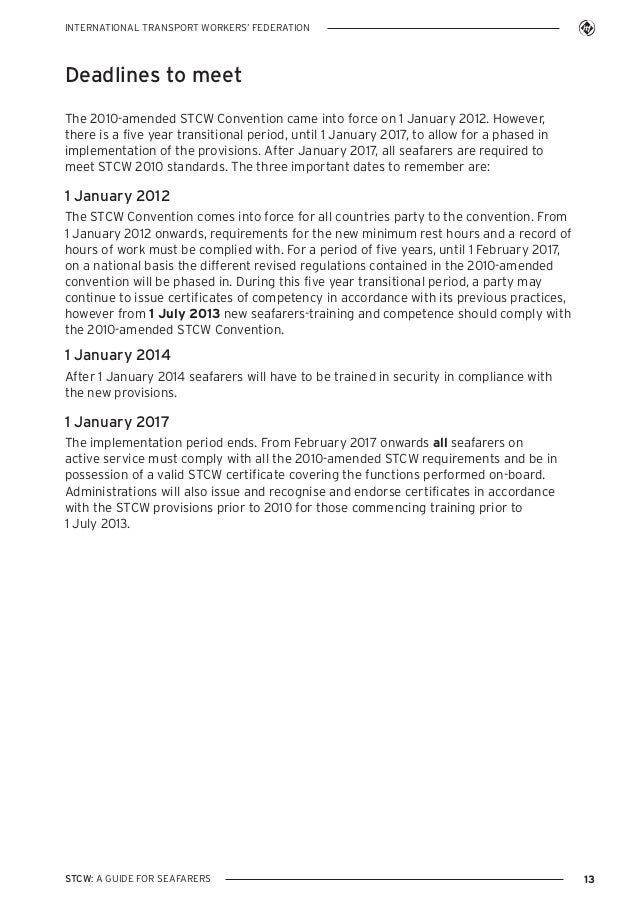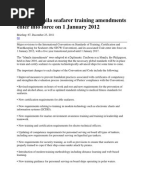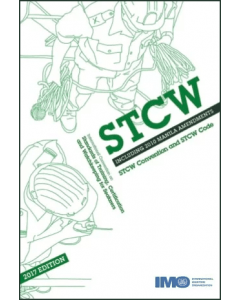Stcw Including 2010 Manila Amendments 2011 Edition Pdf
This guide relates to the 2010 STCW Manila amendments to the International Convention on Standards of Training, Certification and Watch Keeping for Seafarers, 1978. This information is specifically about new training requirements for all seafarers. You will be required to hold these certificates. STCW/CONF.2/34 3 August 2010 Original. The Manila Amendments to the. Amendments to part A of the STCW Code shall be deemed to have been accepted on 1 July 2011.
Jump to navigationJump to search| International Convention on Standards of Training, Certification and Watchkeeping for Seafarers | |
|---|---|
| Signed | 7 July 1978[1] |
| Location | London, UK |
| Effective | 28 April 1984 |
| Condition | 25 ratifications, the combined merchant fleets of which constitute not less than 50% of the gross tonnage of the world's merchant shipping of ships of 100 gross tonnage or more |
| Parties | 164 |
| Depositary | Secretary-General of the Inter-Governmental Maritime Consultative Organization (IMCO) |
| Languages | English, French, Russian and Spanish |
The International Convention on Standards of Training, Certification and Watchkeeping for Seafarers (STCW), 1978 sets minimum qualification standards for masters, officers and watch personnel on seagoing merchant ships and large yachts[2]. STCW was adopted in 1978 by conference at the International Maritime Organization (IMO) in London, and entered into force in 1984. The Convention was significantly amended in 1995.
Stcw 2010 Manila Amendments
The 1978 STCW Convention was the first to establish minimum basic requirements on training, certification and watchkeeping for seafarers on an international level. Previously the minimum standards of training, certification and watchkeeping of officers and ratings were established by individual governments, usually without reference to practices in other countries. As a result, minimum standards and procedures varied widely, even though shipping is extremely international by nature.
The Convention prescribes minimum standards relating to training, certification and watchkeeping for seafarers which countries are obliged to meet or exceed.[3]

The Convention did not deal with manning levels: IMO provisions in this area are covered by regulation 14 of Chapter V of the International Convention for the Safety of Life at Sea (SOLAS), 1974, whose requirements are backed up by resolution A.890(21) Principles of safe manning, adopted by the IMO Assembly in 1999, which replaced an earlier resolution A.481(XII) adopted in 1981.
One especially important feature of the Convention is that it applies to ships of non-party States when visiting ports of States which are Parties to the Convention. Article X requires Parties to apply the control measures to ships of all flags to the extent necessary to ensure that no more favourable treatment is given to ships entitled to fly the flag of a State which is not a Party than is given to ships entitled to fly the flag of a State that is a Party.

The difficulties which could arise for ships of States which are not Parties to the Convention is one reason why the Convention has received such wide acceptance. By 2018, the STCW Convention had 164 Parties, representing 99.2 per cent of world shipping tonnage.
1995 revision[edit]
On 7 July 1995, the IMO adopted a comprehensive revision of STCW. It also included a proposal to develop a new STCW Code, which would contain the technical details associated with provisions of the Convention. The amendments entered force on 1 February 1997[citation needed]. Full implementation was required by 1 February 2002[citation needed]. Mariners already holding certification had the option to renew the certificates in accordance with the old rules of the 1978 Convention during the period ending on 1 February 2002. Mariners entering training programs after 1 August 1998 are required to meet the competency standards of the new 1995 Amendments.
The most significant amendments concerned: Cloud system booster pro serial key.
The model is taken from Forza Horizon. Changes in version 1.1: - Fixed wheel; - Fixed steering wheel; - New mapping; - Bug fixes. Gta vice city mod cars. Features of the model: - The model supports the basic functions of the game; - High-quality 3D model; - The worked out salon; - Adjusted optics; - Engineered model; - Its shadow; - The windows are broken; - Mapping of dirt; - Hands on the handlebars; - The worked out collision; - Reflections in high quality mirrors; - The instrument panel is working; - Realistic Handling.
- a) enhancement of port state control;
- b) communication of information to IMO to allow for mutual oversight and consistency in application of standards,
- c) quality standards systems (QSS), oversight of training, assessment, and certification procedures,
- The Amendments require that seafarers be provided
Manila Amendments[edit]
The IMO Convention on Standards of Training Certification and Watchkeeping of Seafarers adopted a new set of amendments in Manila in 2010 called 'The Manila Amendments'. These amendments were necessary to keep training standards in line with new technological and operational requirements that require new shipboard competencies. The Manila Amendments were effective as of 1 January 2012. There is a transition period until 2017 when all seafarers must be certified and trained according to the new standards. Implementation is progressive, every year a modified set of requirements comes into force. The most significant amendments are:
- New rest hours for seafarers
- New grades of certificates of competency for able seafarers in both deck and engine
- New and updated training, refreshing requirements
- Mandatory security training
- Additional medical standards
- Specific Alcohol limits in blood or breath.
STCW-F Convention[edit]
On 7 July 1995, the International Convention on Standards of Training, Certification and Watchkeeping for Fishing Vessel Personnel was adopted as a separate treaty as part of the comprehensive revisions to STCW. It applies the principles of STCW to fishing vessels from ratifying states that are 24 metres in length and above. STCW-F came into force on 29 September 2012.[4]
See also[edit]
- Merchant Mariner Credential, a US credential
- Seaman Service Book, credential in Pakistan
- Continuous Discharge Certificate, in India
- Merchant Mariner's Document, UK and formerly US

References[edit]
- ^What is STCW?
- ^'What Qualifications do you Need to Work on a Yacht? YPI CREW'. ypicrew.com. Retrieved 18 July 2018.
- ^IMO Model Courses
- ^STCW-F Convention, imo.org.
External links[edit]
- IMO information regarding STCW
- US Coast Guard information regarding STCW
IMO e-Reader KC938E STCW including 2010 Manila Amendments, 2011 Edition
A comprehensive review of the 1978 STCW Convention commenced in January 2006 and culminated in a Conference of Parties to the STCW Convention, held in Manila, Philippines, from 21 to 25 June 2010, that adopted a significant number of amendments to the STCW Convention and STCW Code.
The amendments update standards of competence required, particularly in light of emerging technologies, introduce new training and certification requirements and methodologies, improve mechanisms for enforcement of its provisions, and detail requirements on hours of work and rest, prevention of drug and alcohol abuse and medical fitness standards for seafarers.
This publication contains the Final Act of the 2010 Conference of Parties to the 1978 STCW Convention, resolutions adopted by that Conference, and a complete, consolidated text of the STCW Convention, including its original articles, revised annex and supporting STCW Code.
The Convention articles and annex provide the legal framework within which mandatory technical standards contained in part A of the STCW Code are applied. Part B of the Code provides guidance to assist those involved in educating, training or assessing the competence of seafarers or who are otherwise involved in applying STCW Convention provisions.
While not mandatory, the guidance given has been harmonized through discussions within IMO, involving, where appropriate, consultation with the International Labour Organization. Observance of this guidance will contribute to achieving a more uniform application of Convention requirements.
All parts of this publication must be studied to understand the intent of the Convention fully and to give complete effect to the minimum global standards of knowledge, understanding, experience and professional competence desired by the States that are Parties to it, the industry itself and the general public.
The Convention and part A of the Code form a binding treaty between States, the interpretation of which is governed by the Vienna Convention on the Law of Treaties. The revision aims to bring the Convention and Code up to date with developments since the last full revision and to enable them to address issues that are anticipated to emerge in the foreseeable future in an effort to raise the standards of competence and professionalism of seafarers, upon whom the safety of life, property and the environment depends.